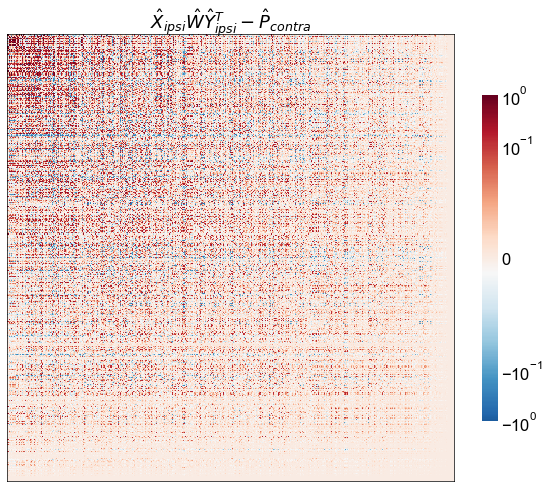Off-diagonal and off-script¶
In Testing bilateral symmetry, we showed that we fail to reject the null hypothesis that the left-to-left and right-to-right induced subgraphs have different latent position distributions under the random dot product graph model.
Here, we ask a slightly different question. In essence, the last notebook showed that
This could have arisen if
That is, the latent positions are approximately equal up to some orthogonal transformation:
However, in some sense we have no way of telling whether there is a “biological Q” given the ipsilateral subgraphs alone. Indeed, we observed that the left-to-left and right-to-right subgraphs were quite similar:
Due to the inherent nonidentifiability in random dot product graphs, we don’t know whether \(Q=I\):
However, \(Q\) does affect our predictions for the “off-diagonal” probabilities. Even if we assume that these probabilities are a function of the same latent positions which generate the ipsilateral subgraphs, we would have
and
and thus \(P_{L \rightarrow R}\) and \(P_{R \rightarrow L}\) would vary in \(Q\), while \(P_{L \rightarrow L}\) and \(P_{R \rightarrow R}\) do not.
Below, we examine whether
By searching over \(Q\) to minimize
Preliminaries¶
from pkg.utils import set_warnings
set_warnings()
import pprint
import time
from datetime import timedelta
import matplotlib.pyplot as plt
import numpy as np
import pandas as pd
import seaborn as sns
from hyppo.ksample import KSample
from scipy.stats import ks_2samp, ortho_group
from giskard.plot import screeplot
from graspologic.align import OrthogonalProcrustes, SeedlessProcrustes
from graspologic.embed import AdjacencySpectralEmbed, select_dimension
from graspologic.plot import pairplot
from graspologic.simulations import sample_edges
from graspologic.utils import (
augment_diagonal,
binarize,
multigraph_lcc_intersection,
pass_to_ranks,
)
from pkg.data import load_adjacency, load_node_meta
from pkg.io import savefig
from pkg.plot import set_theme
from pkg.utils import get_paired_inds, get_paired_subgraphs
from src.visualization import adjplot # TODO fix graspologic version and replace here
from graspologic.utils import largest_connected_component
from matplotlib import cm
t0 = time.time()
def stashfig(name, **kwargs):
foldername = "off_diagonal"
savefig(name, foldername=foldername, **kwargs)
colors = sns.color_palette("Set2")
palette = {"Ipsi": colors[0], "Contra": colors[1]}
set_theme()
/Users/bpedigo/miniconda3/envs/maggot-revamp/lib/python3.8/site-packages/umap/__init__.py:9: UserWarning: Tensorflow not installed; ParametricUMAP will be unavailable
warn("Tensorflow not installed; ParametricUMAP will be unavailable")
Load the data¶
Load node metadata and select the subgraphs of interest¶
meta = load_node_meta()
meta = meta[meta["paper_clustered_neurons"]]
adj = load_adjacency(graph_type="G", nodelist=meta.index)
np.count_nonzero(adj) / adj.size
0.0123998559726348
lp_inds, rp_inds = get_paired_inds(meta)
left_meta = meta.iloc[lp_inds]
right_meta = meta.iloc[rp_inds]
subgraphs = get_paired_subgraphs(adj, lp_inds, rp_inds)
subgraphs = [binarize(sg) for sg in subgraphs]
ipsi_adj = (subgraphs[0] + subgraphs[1]) / 2
contra_adj = (subgraphs[2] + subgraphs[3]) / 2
adjs, lcc_inds = multigraph_lcc_intersection([ipsi_adj, contra_adj], return_inds=True)
ipsi_adj = adjs[0]
contra_adj = adjs[1]
print(f"{len(lcc_inds)} in intersection of largest connected components.")
print(f"Original number of valid pairs: {len(lp_inds)}")
# left_meta = left_meta.iloc[lcc_inds]
# right_meta = right_meta.iloc[lcc_inds]
# meta = pd.concat((left_meta, right_meta))
n_pairs = len(ipsi_adj)
print(f"Number of pairs after taking LCC intersection: {n_pairs}")
1132 in intersection of largest connected components.
Original number of valid pairs: 1149
Number of pairs after taking LCC intersection: 1132
fig, axs = plt.subplots(1, 2, figsize=(10, 5))
ax = axs[0]
adjplot(ipsi_adj, ax=ax, plot_type="scattermap", sizes=(1, 1), color=palette["Ipsi"])
ax = axs[1]
adjplot(
contra_adj, ax=ax, plot_type="scattermap", sizes=(1, 1), color=palette["Contra"]
)
(<AxesSubplot:>,
<mpl_toolkits.axes_grid1.axes_divider.AxesDivider at 0x7ff44d2968b0>,
<AxesSubplot:>,
<AxesSubplot:>)
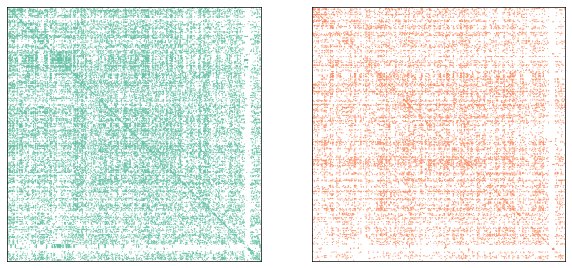
max_n_components = 40
from giskard.utils import careys_rule
ase = AdjacencySpectralEmbed(n_components=max_n_components)
ipsi_out_latent, ipsi_in_latent = ase.fit_transform(ipsi_adj)
ipsi_singular_values = ase.singular_values_
contra_out_latent, contra_in_latent = ase.fit_transform(contra_adj)
contra_singular_values = ase.singular_values_
check_n_components = careys_rule(ipsi_adj)
ax = screeplot(
ipsi_singular_values,
label="Ipsi",
color=palette["Ipsi"],
check_n_components=check_n_components,
)
screeplot(
contra_singular_values,
ax=ax,
label="Contra",
color=palette["Contra"],
check_n_components=check_n_components,
)
<AxesSubplot:title={'center':'Screeplot'}, xlabel='Index', ylabel='Singular value'>
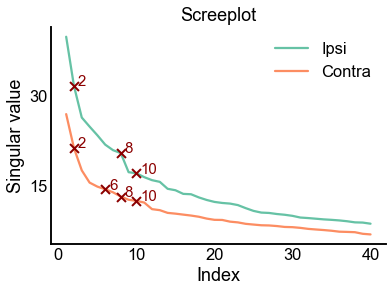
def plot_latents(ipsi, contra, title="", n_show=4):
plot_data = np.concatenate([ipsi, contra], axis=0)
labels = np.array(["Ipsi"] * len(ipsi) + ["Contra"] * len(contra))
pg = pairplot(plot_data[:, :n_show], labels=labels, title=title, palette=palette)
return pg
plot_latents(ipsi_out_latent, contra_out_latent, title="Out latents, no alignment")
plot_latents(ipsi_in_latent, contra_in_latent, title="In latents, no alignment")
<seaborn.axisgrid.PairGrid at 0x7ff461082f70>
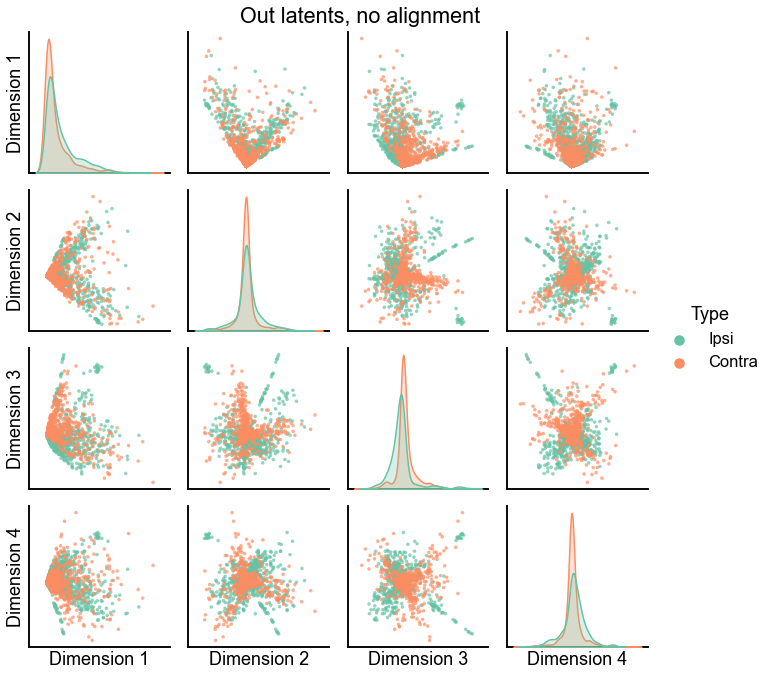
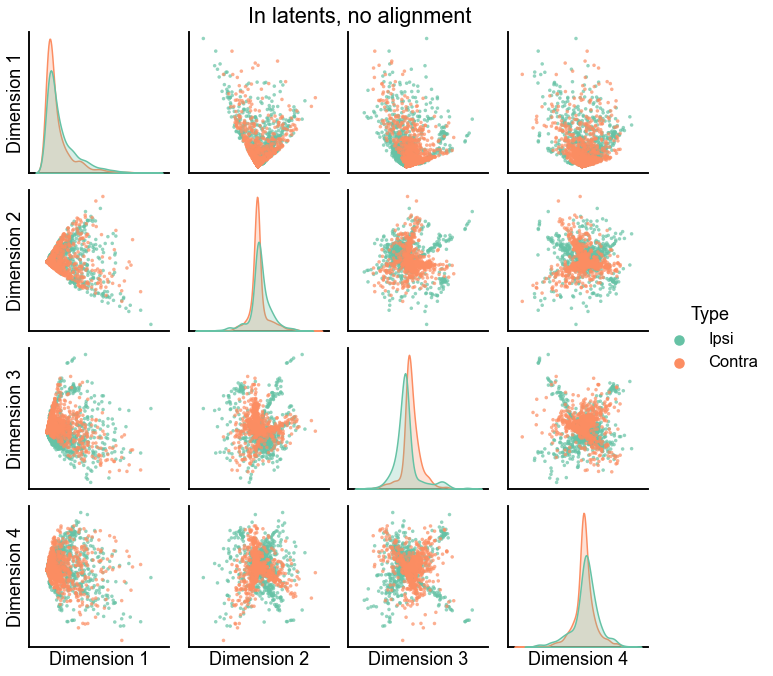
A modified orthogonal Procrustes procedure¶
Motivated by the above, we seek to minimize
which has the same solution as
By the Von Neumman trace theorem,
Here, we know that the singular values of \(W\) are all one, so, letting \(Y^T B^T X = U \Sigma V^T\) be a singular value decomposition,
Let \(W^* = VU^T\), then
Thus, we have achieved the upper bound, and therefore maximized the quantity as desired.
Implementation¶
The implementation of the above is quite simple, below is a simple version in numpy.
def inner_procrustes(X, Y, A):
"""Solves argmin over W of \|X W Y^T - A\|_F^2"""
product = Y.T @ A.T @ X
U, Sigma, Vt = np.linalg.svd(product, full_matrices=False)
W = Vt.T @ U.T
return W
Test this procrustes¶
Here, I let:
\(X\) = the estimated ipsilateral out latent positions
\(Y\) = the estimated ipsilateral in latent positions
\(W\) = a matrix sampled uniformly at random from the orthogonal matrices
\(P\) = \(X W Y^T\)
Then, I estimate \(\hat{W}\) using the modified orthogonal Procrustes proceedure described above. Below I plot the true \(\hat{W}\) and the recovered \(\hat{W}\), and we see that they are nearly the same.
from scipy.stats import ortho_group
n_components = 8
W = ortho_group.rvs(n_components)
X = ipsi_out_latent[:, :n_components]
Y = ipsi_in_latent[:, :n_components]
P = X @ W @ Y.T
W_hat = inner_procrustes(X, Y, P)
heatmap_kws = dict(
square=True, vmin=-1, vmax=1, cbar=False, xticklabels=False, yticklabels=False
)
fig, axs = plt.subplots(1, 2, figsize=(10, 5))
ax = axs[0]
sns.heatmap(W, ax=ax, **heatmap_kws)
ax.set(title=r"$W$")
ax = axs[1]
sns.heatmap(W_hat, ax=ax, **heatmap_kws)
ax.set(title=r"$\hat{W}$")
diff_norm = np.linalg.norm(W - W_hat, ord="fro")
avg_norm = (np.linalg.norm(W) + np.linalg.norm(W_hat)) / 2
print(f"Frobenius norm of difference in solution: {diff_norm}")
print(diff_norm / avg_norm)
Frobenius norm of difference in solution: 0.07881005041404328
0.02786356053671184
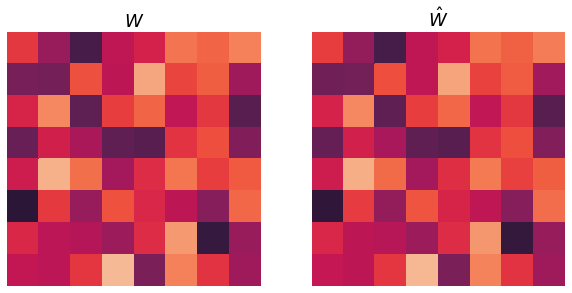
n_components = 16
X_ipsi = ipsi_out_latent[:, :n_components]
Y_ipsi = ipsi_in_latent[:, :n_components]
X_contra = contra_out_latent[:, :n_components]
Y_contra = contra_in_latent[:, :n_components]
W_hat = inner_procrustes(X_ipsi, Y_ipsi, contra_adj)
ipsi_model_P_contra = X_ipsi @ W_hat @ Y_ipsi.T
P_contra = X_contra @ Y_contra.T
fig, axs = plt.subplots(1, 2, figsize=(15, 8))
ax = axs[0]
adjplot(
ipsi_model_P_contra,
plot_type="heatmap",
title=r"$\hat{X}_{ipsi} \hat{W} \hat{Y}_{ipsi}^T$",
cbar=False,
ax=ax,
)
ax = axs[1]
adjplot(
P_contra,
plot_type="heatmap",
title=r"$\hat{P}_{contra}$",
cbar=False,
ax=ax,
)
(<AxesSubplot:title={'center':'$\\hat{P}_{contra}$'}>,
<mpl_toolkits.axes_grid1.axes_divider.AxesDivider at 0x7ff44ee05df0>,
<AxesSubplot:title={'center':'$\\hat{P}_{contra}$'}>,
<AxesSubplot:title={'center':'$\\hat{P}_{contra}$'}>)

from matplotlib.colors import Normalize, SymLogNorm
vmin = -1
vmax = 1
cmap = cm.get_cmap("RdBu_r")
norm = Normalize(vmin, vmax)
norm = SymLogNorm(linthresh=0.1, linscale=2, vmin=vmin, vmax=vmax, base=10)
fig, axs = plt.subplots(1, 2, figsize=(16, 9))
adjplot_kws = dict(
plot_type="heatmap",
cbar=False,
cmap=cmap,
norm=norm,
)
ax = axs[0]
adjplot(
ipsi_model_P_contra,
title=r"$\hat{X}_{ipsi} \hat{W} \hat{Y}_{ipsi}^T$",
ax=ax,
**adjplot_kws,
)
ax = axs[1]
adjplot(
P_contra,
title=r"$\hat{P}_{contra}$",
ax=ax,
**adjplot_kws,
)
fig.colorbar(
cm.ScalarMappable(norm=norm, cmap=cmap),
ax=axs,
orientation="horizontal",
shrink=0.8,
fraction=0.04,
aspect=30,
pad=0.02,
)
<matplotlib.colorbar.Colorbar at 0x7ff43f06a8b0>

diff = ipsi_model_P_contra - P_contra
row_diff_norm = np.linalg.norm(diff, axis=0)
col_diff_norm = np.linalg.norm(diff, axis=1)
mean_diff_norm = (row_diff_norm + col_diff_norm) / 2
sort_inds = np.argsort(mean_diff_norm)[::-1]
fig, axs = plt.subplots(1, 2, figsize=(16, 9))
ax = axs[0]
adjplot(
ipsi_model_P_contra[np.ix_(sort_inds, sort_inds)],
title=r"$\hat{X}_{ipsi} \hat{W} \hat{Y}_{ipsi}^T$",
ax=ax,
**adjplot_kws,
)
ax = axs[1]
adjplot(
P_contra[np.ix_(sort_inds, sort_inds)],
title=r"$\hat{P}_{contra}$",
ax=ax,
**adjplot_kws,
)
fig.colorbar(
cm.ScalarMappable(norm=norm, cmap=cmap),
ax=axs,
orientation="horizontal",
shrink=0.8,
fraction=0.04,
aspect=30,
pad=0.02,
)
stashfig("contra-model-compare-log-diffsort")
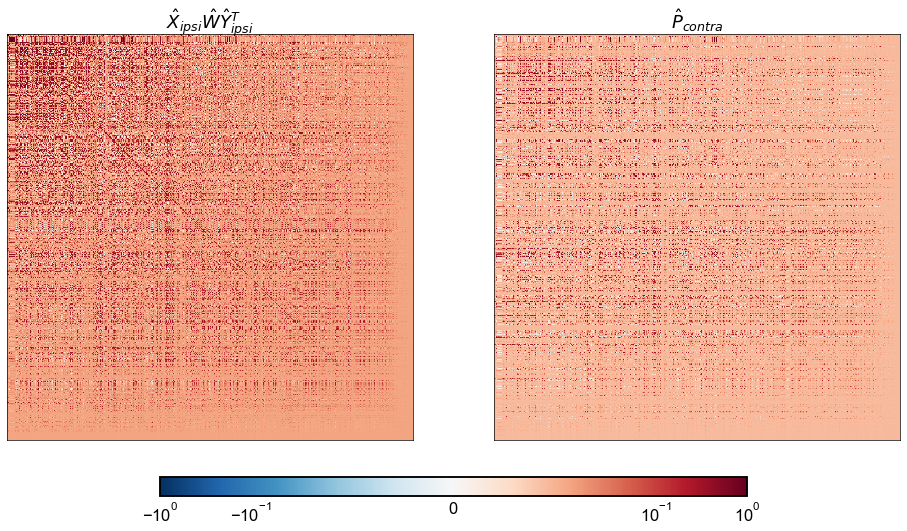
fig, ax = plt.subplots(1, 1, figsize=(10, 10))
adjplot_kws = dict(
plot_type="heatmap", cbar=True, cmap=cmap, norm=norm, cbar_kws=dict(shrink=0.6)
)
adjplot(
diff[np.ix_(sort_inds, sort_inds)],
title=r"$\hat{X}_{ipsi} \hat{W} \hat{Y}_{ipsi}^T - \hat{P}_{contra}$",
ax=ax,
**adjplot_kws,
)
stashfig("contra-model-diff-log-diffsort")
